The Combined Spectral Response of a MEMS Metamaterial Absorber for the Mid-IR and Its Sub-Wavelength Fabrication Residual Array of Holes
Abstract
1. Introduction
2. Impact of the Thermal Design of a Thermal Detector
3. Analysis of Spectral Absorption in a Metamaterial—Hole Array Structure
3.1. The Nominal Metamaterial Unit-Cell Design
3.2. Surface Micromachining and the Plasmonic Response of the Resulting Pattern of Holes
3.3. Spectral Absorbance of a Metasurface That Is Interrupted by an Array of Holes
4. Validation and Discussion
5. Conclusions
Author Contributions
Funding
Data Availability Statement
Conflicts of Interest
References
- Chen, Y.; Li, H.; Li, M. Flexible and tunable silicon photonic circuits on plastic substrates. Nat. Sci. Rep. 2012, 2, 622. [Google Scholar] [CrossRef] [PubMed]
- Rabiei, P.; Ma, J.; Khan, S.; Chiles, J.; Fathpour, S. Heterogeneous lithium niobate photonics on silicon substrates. Opt. Express 2013, 21, 25573–25581. [Google Scholar] [CrossRef] [PubMed]
- Singh, V.; Lin, P.T.; Patel, N.; Lin, H.; Li, L.; Zou, Y.; Deng, F.; Ni, C.; Hu, J.; Giammarco, J.; et al. Mid-infrared materials and devices on a Si platform for optical sensing. Sci. Technol. Adv. Mater. 2014, 15, 014603. [Google Scholar] [CrossRef]
- Chuang, L.C.; Sedgwick, F.G.; Chen, R.; Ko, W.S.; Moewe, M.; Ng, K.W.; Tran, T.D.; Chang-Hasnain, C. GaAs-based nano-needle light emitting diode and avalanche photodiode monolithically integrated on a silicon substrate. ACS Nano Lett. 2011, 11, 385–390. [Google Scholar] [CrossRef]
- Taboada, A.G.; Meduňa, M.; Salvalaglio, M.; Isa, F.; Kreiliger, T.; Falub, C.V.; Barthazy Meier, E.; Müller, E.; Miglio, L.; Isella, G.; et al. GaAs/Ge crystals grown on Si substrates patterned down to the micron scale. J. Appl. Phys. 2016, 119, 055301. [Google Scholar] [CrossRef]
- Wolffenbuttel, R.F. Optical sensors based on photon detection. In Smart Sensor Systems; Meijer, G.C.M., Ed.; Wiley: Hoboken, NJ, USA, 2008; pp. 79–120. [Google Scholar]
- Xu, D.; Wang, Y.; Xiong, B.; Li, T. MEMS-based thermoelectric infrared sensors: A review. Front. Mech. Eng. 2017, 12, 557–566. [Google Scholar] [CrossRef]
- Talghader, J.J.; Gawarikar, A.S.; Shea, R.P. Spectral selectivity in infrared thermal detection. Nat. Light Sci. Appl. 2012, 1, 24. [Google Scholar] [CrossRef]
- Parsons, A.D.; Pedder, D.J. Thin-film infrared absorber structures for advanced thermal detectors. J. Vac. Sci. Technol. A Vac. Surf. Films 1988, 6, 1686–1689. [Google Scholar] [CrossRef]
- Wu, H.; Emadi, A.; Sarro, P.M.; de Graaf, G.; Wolffenbuttel, R.F. A surface micromachined thermopile detector array with an interference-based absorber. J. Micromech. Microeng. 2011, 21, 074009. [Google Scholar] [CrossRef]
- Ghaderi, M.A.; Shahmarvandi, E.K.; Wolffenbuttel, R.F. CMOS-compatible mid-IR metamaterial absorbers for out-of-band suppression in optical MEMS. Opt. Mater. Express 2018, 8, 1696–1707. [Google Scholar] [CrossRef]
- Kats, M.A.; Capasso, F. Optical absorbers based on strong interference in ultra-thin films. Laser Photonics Rev. 2016, 10, 735–749. [Google Scholar] [CrossRef]
- John, L.; Evangelos, T.; George, E.; Chris, P. Gold-black coatings for freestanding pyroelectric detectors. Meas. Sci. Technol. 2003, 14, 916. [Google Scholar]
- Gokhale, V.J.; Shenderova, O.A.; McGuire, G.E.; Rais-Zadeh, M. Infrared Absorption Properties of Carbon Nanotube/Nanodiamond Based Thin Film Coatings. J. Microelectromech. Syst. 2014, 23, 191–197. [Google Scholar] [CrossRef]
- Gheitaghya, A.M.; Ghaderi, M.A.; Vollebregt, S.; Ahmadi, M.; Wolffenbuttel, R.F.; Zhan, G.Q. Infrared absorbance of vertically aligned multi-walled CNT forest as a function of synthesis temperature and time. Mat. Res. Bull. 2020, 126, 110821. [Google Scholar] [CrossRef]
- Lee, Y.P.; Rhee, J.Y.; Yoo, Y.J.; Kim, K.W. Metamaterials for Perfect Absorption; Springer: Singapore, 2016; Volume 236. [Google Scholar]
- Adomanis, B.M.; Watts, C.M.; Koirala, M.; Liu, X.; Tyler, T.; West, K.G.; Starr, T.; Bringuier, J.N.; Starr, A.F.; Jokerst, N.M.; et al. Bi-layer metamaterials as fully functional near-perfect infrared absorbers. Appl. Phys. Lett. 2015, 107, 021107. [Google Scholar] [CrossRef]
- Li, A.; Singh, S.; Sievenpiper, D. Metasurfaces and their applications. Nanophotonics 2018, 7, 989–1011. [Google Scholar] [CrossRef]
- Hodgkinson, J.; Tatam, R.P. Optical gas sensing: A review. IOP Publ. Meas. Sci. Technol. 2013, 24, 012004. [Google Scholar] [CrossRef]
- Wolffenbuttel, R.F.; Ghaderi, M.A. Design of large-area metasurfaces for the mid-IR and suited for CMOS-compatible fabrication by masked lithography. Photonics Nanostruct.-Fundam. Appl. 2022, 51, 101050. [Google Scholar] [CrossRef]
- Lochbaum, A.; Dorodnyy, A.; Koch, U.; Koepfli, S.M.; Volk, S.; Fedoryshyn, Y.; Wood, V.; Leuthold, J. Compact mid-infrared gas sensing enabled by an all-metamaterial design. ACS Nano Lett. 2020, 20, 4169–4176. [Google Scholar] [CrossRef]
- Zhao, X.; Duan, G.; Li, A.; Chen, C.; Zhang, X. Integrating microsystems with metamaterials towards meta-devices. Microsyst. Nanoeng. 2019, 5, 5. [Google Scholar] [CrossRef]
- Nazdrowicz, J.; Szermer, M.; Maj, C.; Zabierowski, W.; Napieralski, A. A study on microbolometer electro-thermal circuit modelling. In Proceedings of the 22th IEEE International Conference on Mixed Design of Integrated Circuits and Systems, Torun, Poland, 25–27 June 2015; pp. 458–463. [Google Scholar]
- Niesler, F.B.P.; Gansel, J.K.; Fischbach, S.; Wegener, M. Metamaterial metal-based bolometers. Appl. Phys. Lett. 2012, 100, 203508. [Google Scholar] [CrossRef]
- Kim, Y.; Kim, D.; Lee, S.H.; Seo, M.; Jung, H.J.; Kang, B.; Lee, S.M.; Lee, H.J. Single-layer metamaterial bolometer for sensitive detection of low-power terahertz waves at room temperature. Opt. Express 2020, 28, 17143–17152. [Google Scholar] [CrossRef] [PubMed]
- Dao, T.D.; Doan, A.T.; Ishii, S.; Yokoyama, T.; Ørjan, H.S.; Ngo, D.H.; Ohki, T.; Ohi, A.; Wada, Y.; Niikura, C.; et al. MEMS-based wavelength-selective bolometers. Micromachines 2019, 10, 416. [Google Scholar] [CrossRef]
- Liu, X.; Tyler, T.; Starr, T.; Starr, A.F.; Jokerst, N.M.; Padilla, W.J. Taming the blackbody with infrared metamaterials as selective thermal emitters. Phys. Rev Lett. 2011, 107, 045901. [Google Scholar] [CrossRef] [PubMed]
- Lochbaum, A.; Fedoryshyn, Y.; Dorodnyy, A.; Koch, U.; Hafner, C.; Leuthold, J. On-chip narrowband thermal emitter for mid-IR optical gas sensing. ACS Photonics 2017, 4, 1371–1380. [Google Scholar] [CrossRef]
- Comsol. Available online: https://www.comsol.com/ (accessed on 1 March 2023).
- Huang, J. Theory of LC circuit-based metamaterials. J. Nanophotonics 2017, 11, 016016. [Google Scholar] [CrossRef]
- Ding, F.; Dai, J.; Chen, Y.; Jin, Y.; Bozhevolny, S.I. Broadband near-infrared metamaterial absorbers utilizing highly lossy metals. Nat. Sci. Rep. 2016, 6, 39445. [Google Scholar] [CrossRef]
- Bustillo, J.M.; Howe, R.T.; Muller, R.S. Surface micromachining for micromechanical systems. Proc. IEEE 1998, 86, 1552–1574. [Google Scholar] [CrossRef]
- Lee, Y.; Park, K.; Lee, J.; Lee, C.; Yoo, H.; Kim, C. Dry release for surface micromachining with HF vapor-phase etching. J. Microelectromech. Syst. 1997, 6, 226–232. [Google Scholar] [CrossRef]
- Dao, T.D.; Ishii, S.; Yokoyama, T.; Sawada, T.; Sugavaneshwar, R.P.; Chen, K.; Wada, Y.; Nabatame, T.; Nagao, T. Hole array perfect absorbers for spectrally selective mid-wavelength infrared pyroelectric detectors. ACS Photonics 2016, 3, 1271–1278. [Google Scholar] [CrossRef]
- Blanchard-Dionne, A.; Guyot, L.; Patskovsky, S.; Gordon, R.; Meunier, M. Intensity based surface plasmon resonance sensor using a nanohole rectangular array. Opt. Express 2011, 19, 15041–15046. [Google Scholar] [CrossRef] [PubMed]
- Kischkat, J.; Peters, S.; Gruska, B.; Semtsiv, M.; Chashnikova, M.; Klinkmüller, M.; Fedosenko, O.; Machulik, S.; Aleksandrova, A.; Monastyrskyi, G.; et al. Mid-infrared optical properties of thin films of aluminum oxide, titanium dioxide, silicon dioxide, aluminum nitride, and silicon nitride. Appl. Opt. 2012, 51, 6789–6798. [Google Scholar] [CrossRef] [PubMed]
- Rakić, A.D.; Djurišić, A.B.; Elazar, J.M.; Majewski, M.L. Optical properties of metallic films for vertical-cavity optoelectronic devices. Appl. Opt. 1998, 37, 5271–5283. [Google Scholar] [CrossRef] [PubMed]
- Gall, D. Electron mean free path in elemental metals. J. Appl. Phys. 2016, 119, 085101. [Google Scholar] [CrossRef]
- Mayadas, A.F.; Shatzkes, M. Electrical-resistivity model for polycrystalline films: The case of arbitrary reflection at external surfaces. Phys. Rev. B 1970, 1, 1382–1389. [Google Scholar] [CrossRef]
- Marom, H.; Eizenberg, M. The effect of surface roughness on the resistivity increase in nanometric dimensions. J. Appl. Phys. 2006, 99, 123705. [Google Scholar] [CrossRef]
- Camacho, J.M.; Oliva, A.I. Surface and grain boundary contributions in the electrical resistivity of metallic nanofilms. Thin Solid Films 2006, 515, 1881–1885. [Google Scholar] [CrossRef]
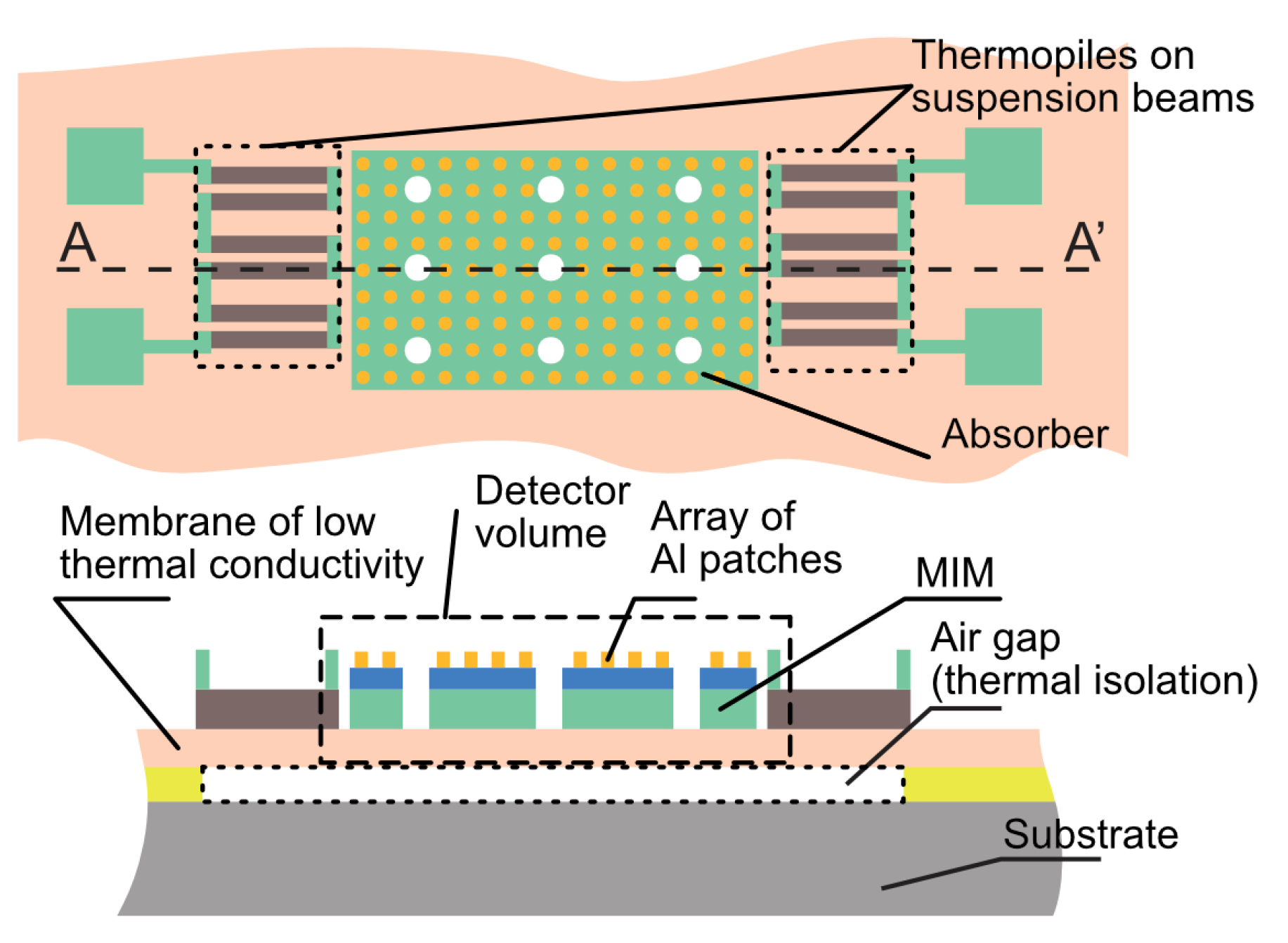
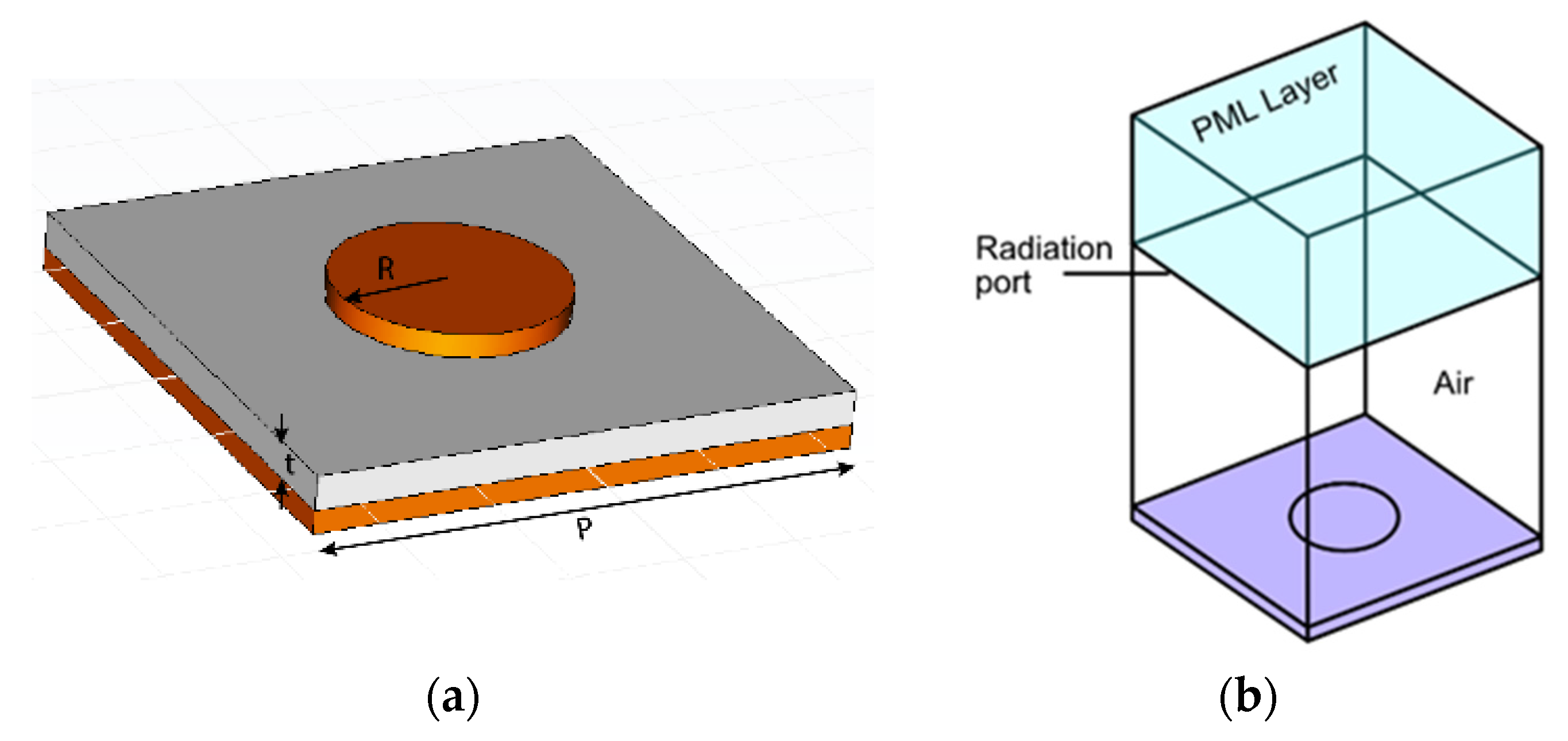
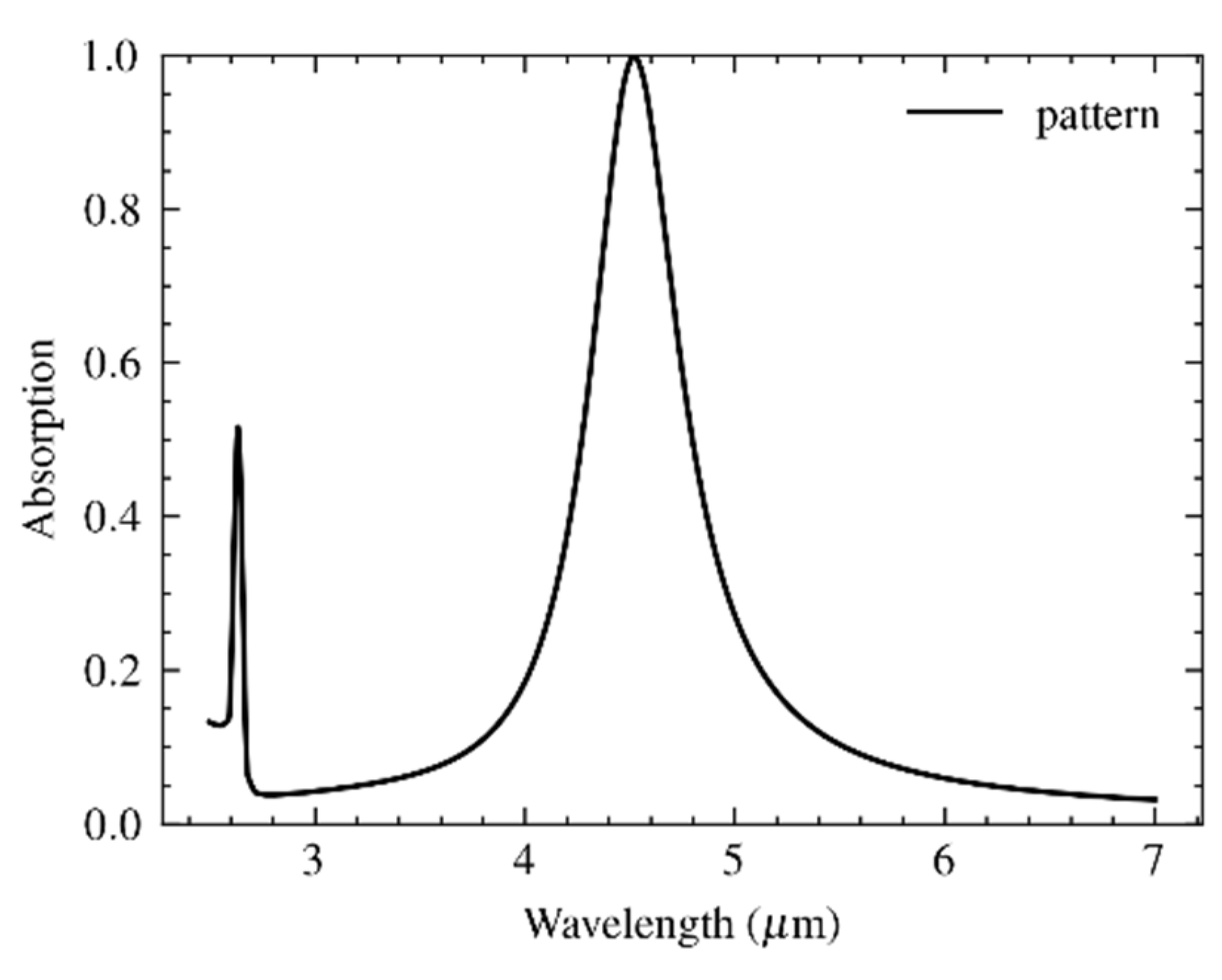
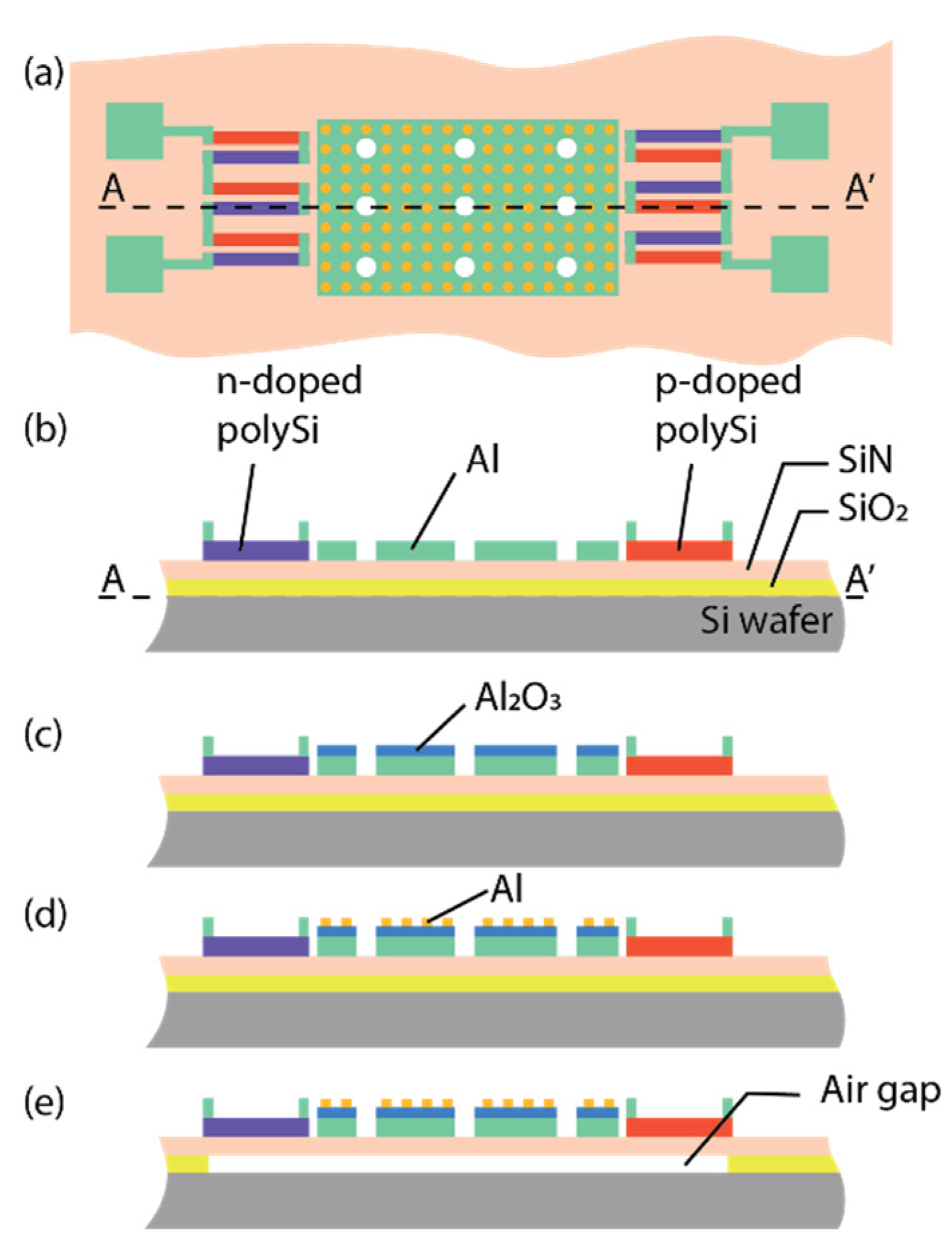
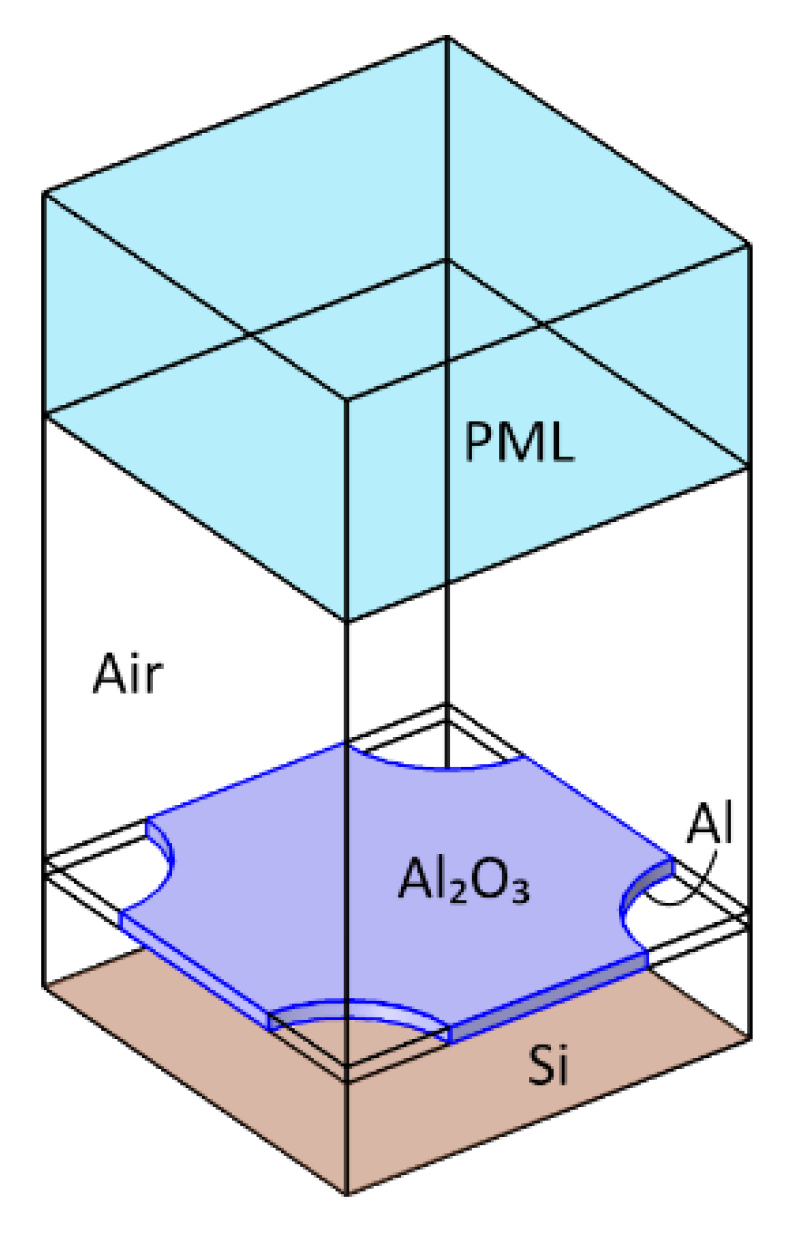
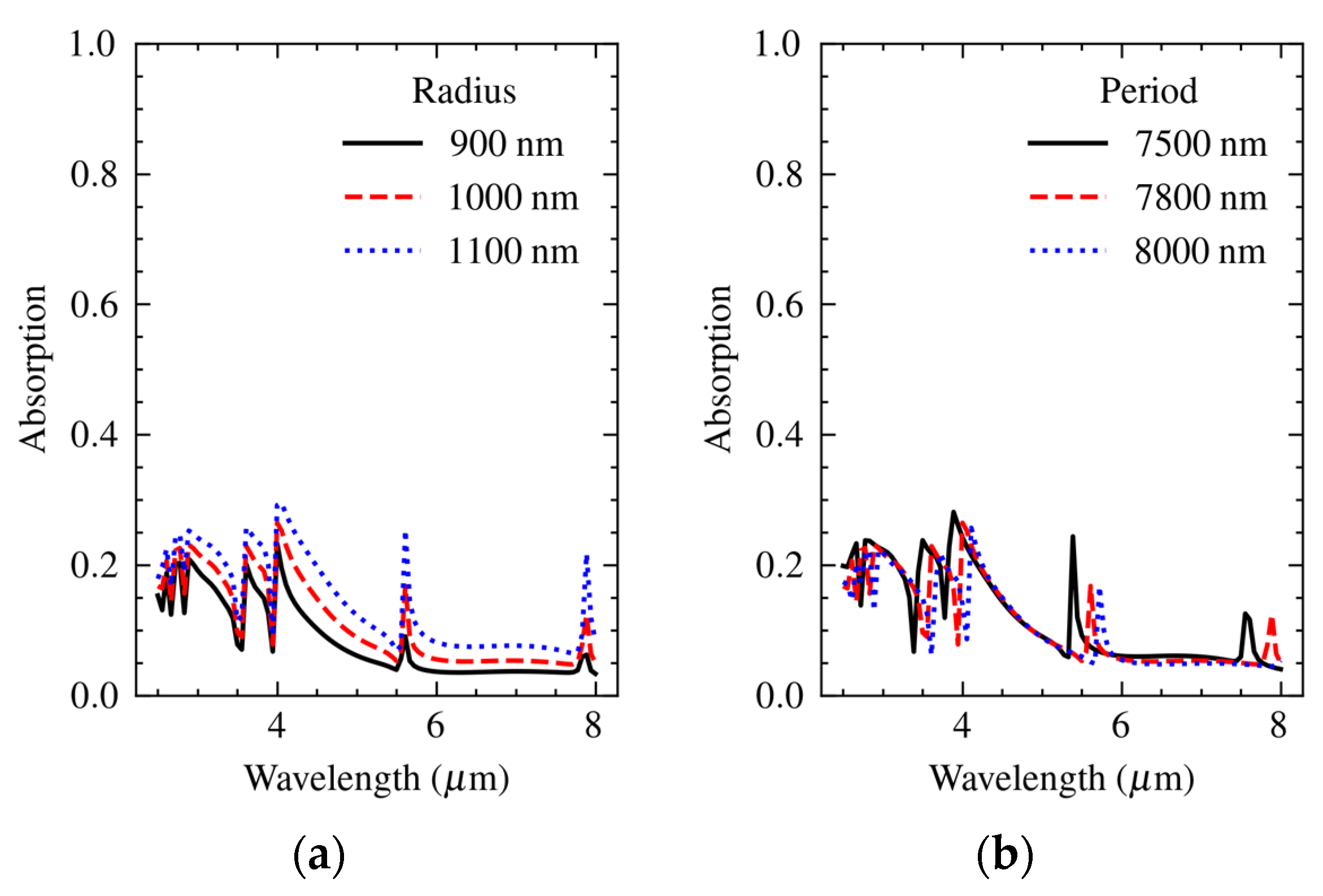

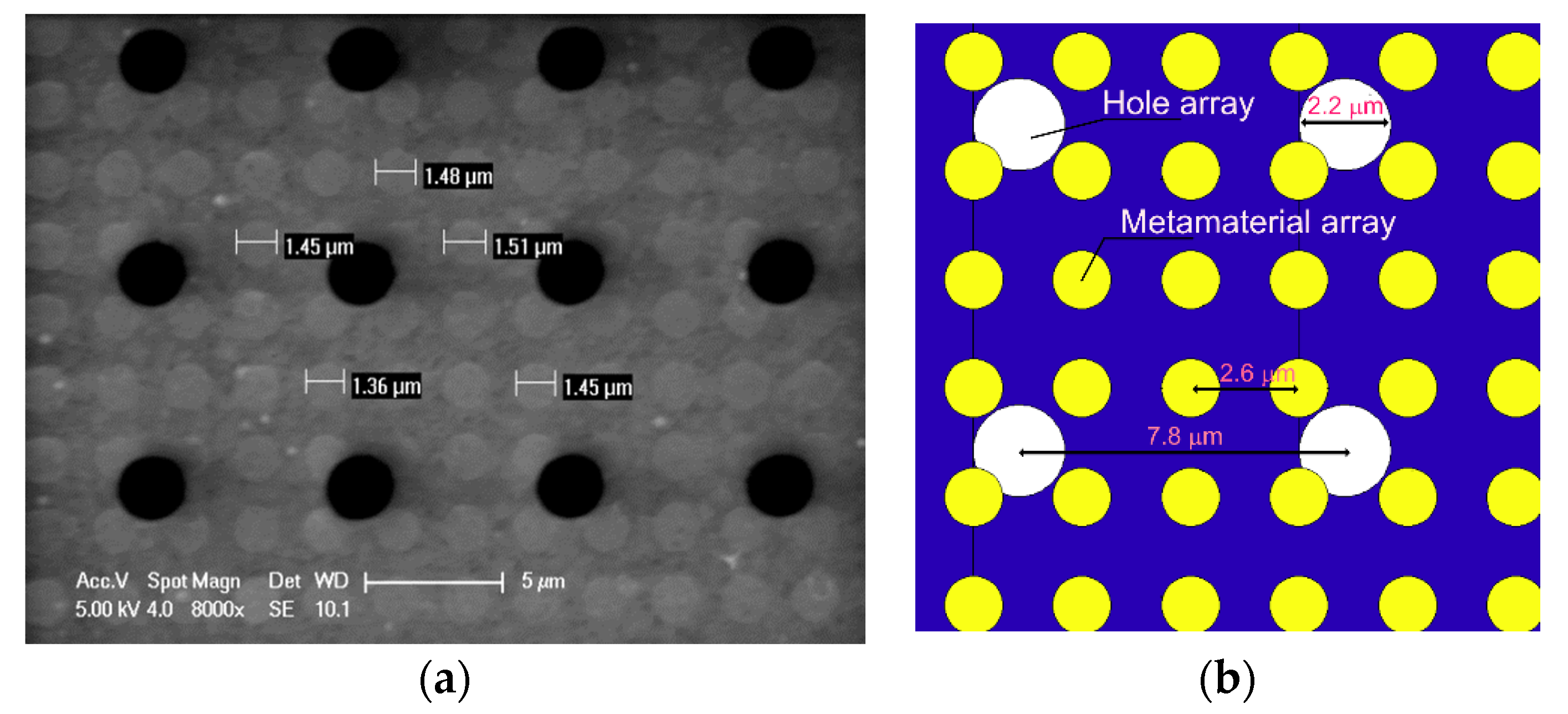


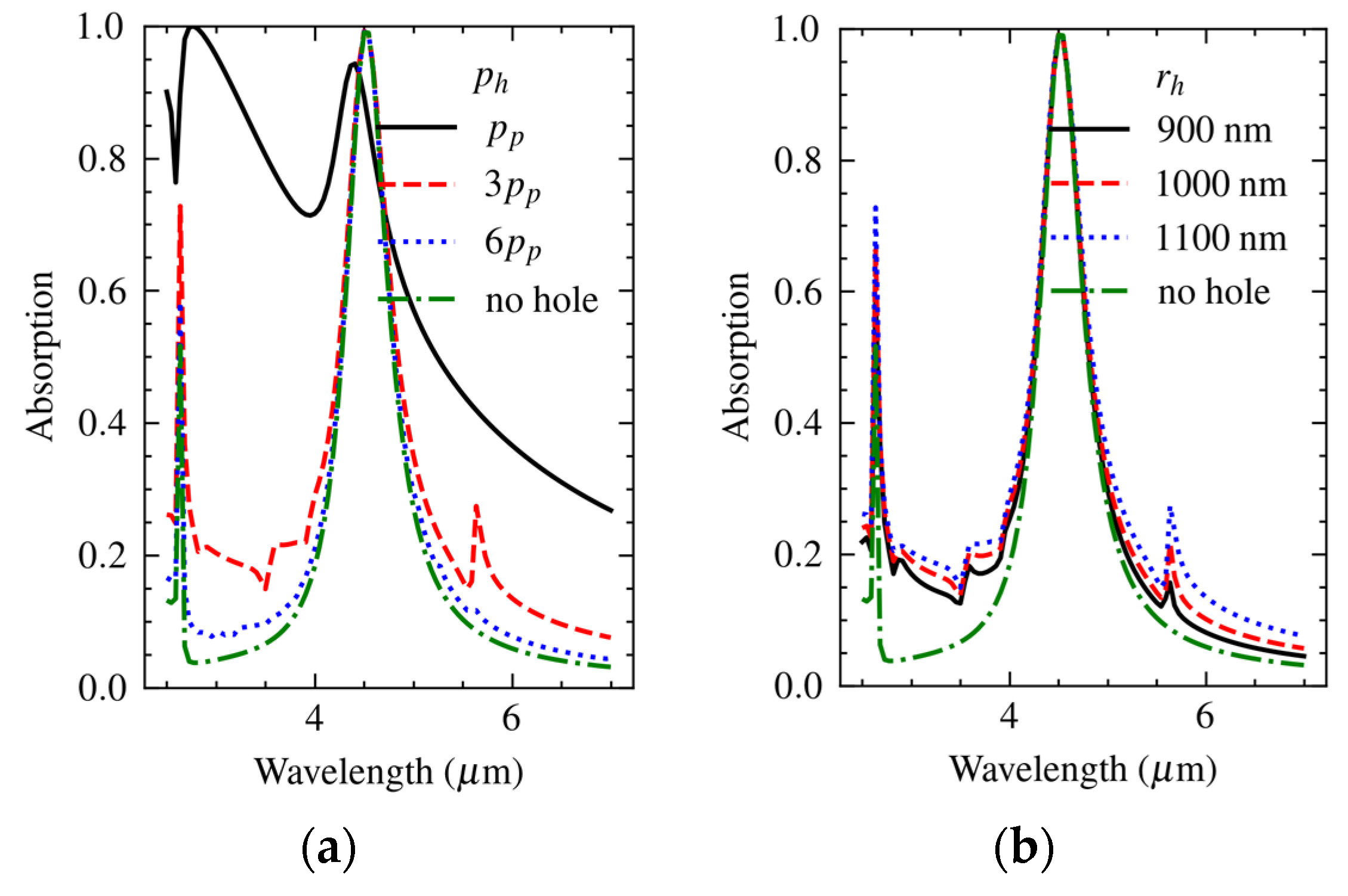
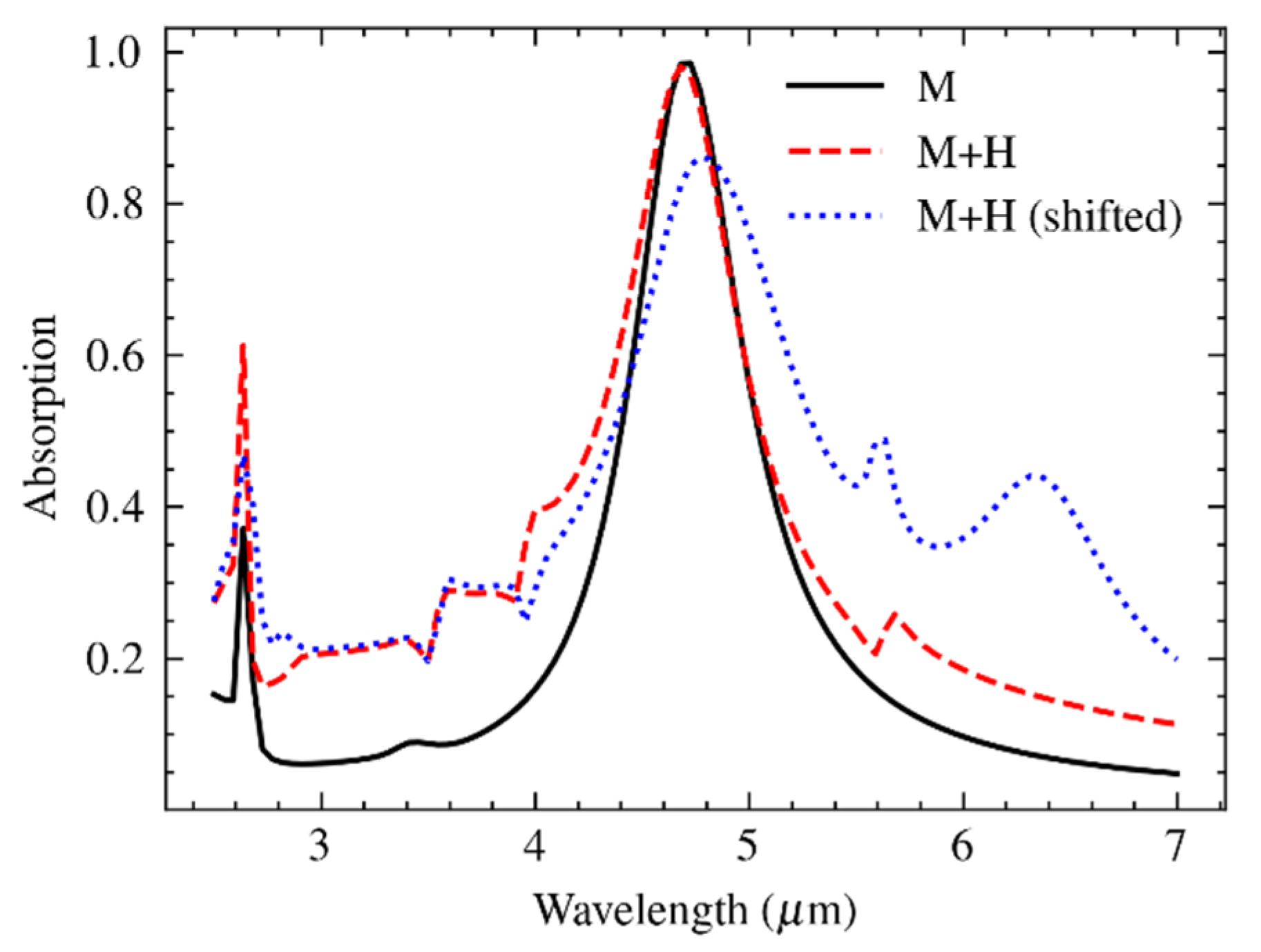
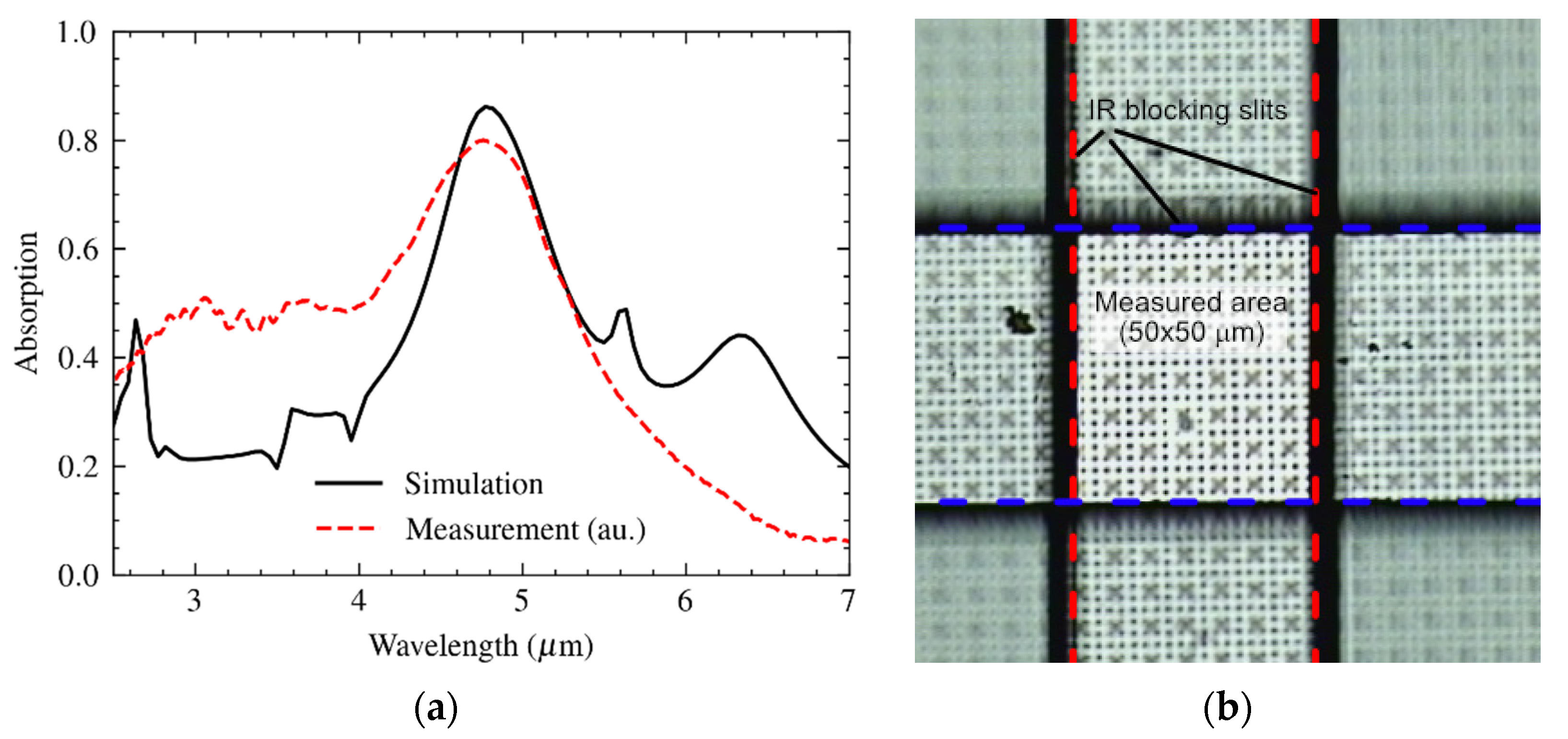
Disclaimer/Publisher’s Note: The statements, opinions and data contained in all publications are solely those of the individual author(s) and contributor(s) and not of MDPI and/or the editor(s). MDPI and/or the editor(s) disclaim responsibility for any injury to people or property resulting from any ideas, methods, instructions or products referred to in the content. |
© 2023 by the authors. Licensee MDPI, Basel, Switzerland. This article is an open access article distributed under the terms and conditions of the Creative Commons Attribution (CC BY) license (https://creativecommons.org/licenses/by/4.0/).
Share and Cite
Wolffenbuttel, R.F.; Ghaderi, M.A. The Combined Spectral Response of a MEMS Metamaterial Absorber for the Mid-IR and Its Sub-Wavelength Fabrication Residual Array of Holes. Materials 2023, 16, 4278. https://doi.org/10.3390/ma16124278
Wolffenbuttel RF, Ghaderi MA. The Combined Spectral Response of a MEMS Metamaterial Absorber for the Mid-IR and Its Sub-Wavelength Fabrication Residual Array of Holes. Materials. 2023; 16(12):4278. https://doi.org/10.3390/ma16124278
Chicago/Turabian StyleWolffenbuttel, Reinoud F., and M. Amir Ghaderi. 2023. "The Combined Spectral Response of a MEMS Metamaterial Absorber for the Mid-IR and Its Sub-Wavelength Fabrication Residual Array of Holes" Materials 16, no. 12: 4278. https://doi.org/10.3390/ma16124278
APA StyleWolffenbuttel, R. F., & Ghaderi, M. A. (2023). The Combined Spectral Response of a MEMS Metamaterial Absorber for the Mid-IR and Its Sub-Wavelength Fabrication Residual Array of Holes. Materials, 16(12), 4278. https://doi.org/10.3390/ma16124278





